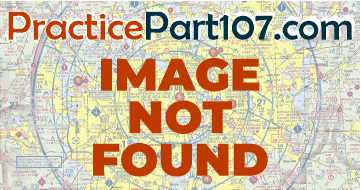FAA(Refer to FAA-CT-8080-2H, Figure 12.) What are the current conditions for Chicago Midway Airport (KMDW)?
- ✅A:Sky 700 feet overcast, visibility 1-1/2SM, rain.
- ❌B:Sky 7,000 feet overcast, visibility 1-1/2SM, heavy rain.
- ❌C:Sky 700 feet overcast, visibility 11, occasionally 2SM, with rain.

FAA-CT-8080-2H Figure 12 Area None - Click to enlarge.
Answer Figure

Click to enlarge answer figure
Explanations
- A: Correct. The METAR for KMDW reads: 'SPECI KMDW 121856Z 32005KT 1 1/2SM RA OVC007 17/16 A2980'. 'OVC007' means the sky is overcast at 700 feet AGL. '1 1/2SM' indicates visibility is 1.5 statute miles. 'RA' means rain is falling, but no intensity is specified, so it is interpreted as moderate rain by default. Correctly interpreting METAR reports is crucial for safe and efficient drone operations, especially for businesses conducting operations near airports or in controlled airspace.
- B: Incorrect. This choice states the ceiling is 7,000 feet, but the METAR indicates 'OVC007', which means 700 feet. Additionally, it says 'heavy rain,' but the METAR only includes 'RA' (moderate rain). Misinterpretation of weather conditions can lead to safety risks, regulatory violations, and operational inefficiencies.
- C: Incorrect. This choice misstates the visibility. The METAR shows visibility as '1 1/2SM' (1.5 statute miles), not '11, occasionally 2SM'. Misunderstanding visibility conditions can lead to unsafe operations and potential regulatory violations.
🧭 Instructor Note
Why This Matters for Your Business
Understanding METAR reports is crucial for any drone business. These reports provide real-time weather conditions at airports, which can significantly impact drone operations. Misinterpretation can lead to safety risks, regulatory violations, and operational inefficiencies, all of which can harm your business's reputation and bottom line.
Safety & Liability Considerations
Incorrectly interpreting a METAR report can lead to unsafe flight conditions, increasing the risk of collision, damage, or injury. Additionally, flying in poor weather conditions can lead to regulatory violations, resulting in fines and potential legal issues.
Consider This Scenario
Imagine a drone inspection company tasked with inspecting infrastructure near Chicago Midway Airport. Misinterpreting the METAR report could lead to the drone being flown in unsafe conditions, risking damage to the drone, the infrastructure, and potentially causing injury. The company could also face regulatory fines for violating weather-related flight restrictions.
What the FAA is Testing
The FAA wants to ensure that remote pilots can correctly interpret METAR reports. This knowledge is critical for maintaining safety and complying with weather-related flight restrictions.
Business Success Strategy
Ensure all drone operators in your business are trained in interpreting METAR reports. Regularly review METAR reports before flights, especially when operating near airports or in controlled airspace. Use weather forecasting tools and services to supplement METAR reports and provide a more comprehensive view of weather conditions.
Memory Aid
Remember that in METAR reports, the sky condition (SKC, FEW, SCT, BKN, OVC) is followed by a three-digit number representing the altitude in hundreds of feet. For visibility, the distance is given in statute miles (SM).
Enhanced References
FAA Aeronautical Information Manual (AIM), Chapter 7: Aviation Weather Services, Section 1: METAR.
Related Concepts
- Reading METARs
- Ceiling and visibility interpretation
- Weather impact on UAS operations
ACS Code: UA.III.A.K2
Difficulty: intermediate
